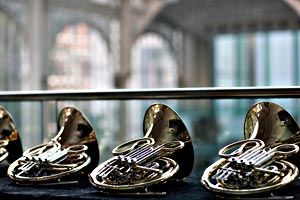Tambourine Technique (Dave Hagedorn, 2002)
Tambourine Technique
by Dave Hagedorn
While other instrumental musicians work diligently to develop their technique on their chosen instrument, percussionists must develop their technique on five FAMILIES of instruments: drums, mallet instruments, timpani, drum set, and auxiliary percussion instruments. Too often, percussionists take auxiliary instruments for granted. They spend countless hours developing their technique on the drums, timpani, mallets, and drum set while ignoring the technique of auxiliary percussion instruments. This article will address the proper technique for playing one of the auxiliary percussion instruments — the tambourine.
First it is very important to have the correct type of tambourine for each playing situation. For concert band a tambourine that has a head on it should be used. The head is imperative for producing sounds that blend with the rest of the musicians and also for doing certain types of rolls. There are two types of heads: plastic and natural skin. For most situations the plastic head works well and is not as affected by changes in the weather and humidity.
In addition to the head material, there are different materials used for the jingles, such as silver and brass. It is important to try out the instrument to determine which sound is most appealing to both the percussionist and the director. I prefer a double row of silver jingles.
When using the tambourine in a jazz ensemble or rock band, I prefer the headless “half-moon” shape. It is lighter and my arm will not tire out as quickly. A plastic shell is lighter and more durable.
Playing the tambourine requires proper technique; proper technique requires time in the practice room to develop. Too often percussionists just pick up the instrument and try to make sounds, without first understanding the details that go into making a quality tambourine sound.
Next we need to address the way the percussionist picks up the tambourine. The jingles are sensitive. We don’t want to inform the audience that we are going to play the tambourine before the musical passage begins. Neither the composer, conductor, nor fellow musicians will appreciate a tambourine sounding over a delicate flute or oboe passage. To avoid this the tambourine should be kept head up on a trap table or padded music stand. When ready to play, keep the head parallel to the floor until after the first note is struck. When setting the tambourine down after playing, take the same care to avoid unwanted sounds.
There are many ways to play individual notes on the tambourine. Hold the tambourine in one hand and experiment, striking it with a fingertip on different places on the head. Next make a “bouquet” of two or more fingers and compare that sound. Try playing with the flat palm of your hand in the center of the head, and also try making a sound with your knuckles. These techniques will give the percussionist a “repertoire” of dynamics and timbres. Remember that most of the time we are adding to the ensemble and not necessarily playing a solo. It’s important to have the sound of the other instruments in mind in order to make the tambourine blend with any and all combinations of instruments.
The basic finger technique is illustrated on page 11 of Standard of Excellence, Book 1. This technique can be practiced by using the rhythm studies on pages 43–45 of Standard of Excellence, Book 1 and pages 44–45 of Standard of Excellence, Book 2.
When playing rapid rhythms, place the tambourine on a padded music stand and use both hands. Try to make both hands sound the same.
Young percussionists should be sure to practice the rhythms in the back of their Standard of Excellence books.
Another technique that must be mastered is the tambourine roll. There are two types: shake rolls and finger rolls. When performing the shake roll, the percussionist should start and end the roll by striking the tambourine on the head. This gives definition to the roll, similar to the technique used on the snare drum. This technique should also be used for rolls requiring a soft volume, eliminating an unwanted jingle sound when preparing to do the roll. This technique is illustrated in Standard of Excellence, Book 2 page 9.
For more control at softer dynamics, use a finger or thumb roll. This involves moistening the finger or thumb and making it vibrate around the edge of the head. Some percussionists like to use a rubber thimble or attach very fine sandpaper around the perimeter of the head for this technique. Other percussionists use beeswax. Finger rolls are crucial to learn, and are used for short bursts of sound that will blend with the ensemble. The thumb or finger roll is illustrated on page 16 of Standard of Excellence, Book 3.
In addition to practicing the exercises in Standard of Excellence, young percussionists can benefit from using this technique on snare drum exercises that have short rolls.
For pop music or jazz ensemble, the biggest problem is being able to play a groove for an extended period of time without getting sore hands or tired muscles. It is difficult to maintain a steady tempo when we get tired. It helps to hold the tambourine in your strongest hand, perpendicular to the floor and shake sixteenth or eighth notes with a side to side motion for a few minutes at a time. To play accents in a constant groove passage, hold a clave in one hand and strike the tambourine on the accents with the clave. It’s very important to “lock in” with the hi-hat cymbal or ride cymbal. A good source to practice is the Standard of Excellence Jazz Ensemble Method using the recording and written part for “Martian Square Dance” on pages 13–15.
Practicing these techniques will improve your tambourine playing and make for more enjoyable and musical sounds.
__________
Dave Hagedorn is a professional percussionist in the Twin Cities of Minneapolis and St. Paul. He is the percussion instructor at St. Olaf College in Northfield, Minnesota.
All illustrations are taken from the Standard of Excellence Comprehensive Band Method published by the Neil A. Kjos Music Company.
Copyright © 2002 Neil A. Kjos Music Company. All rights reserved. Spring 2002, Volume 5.










